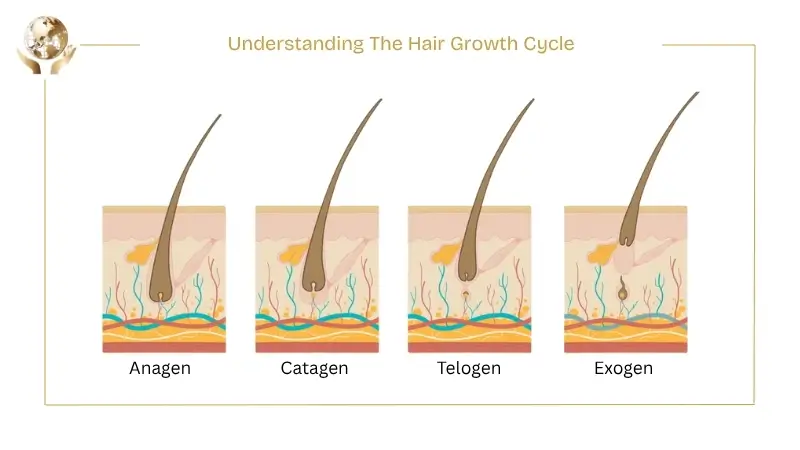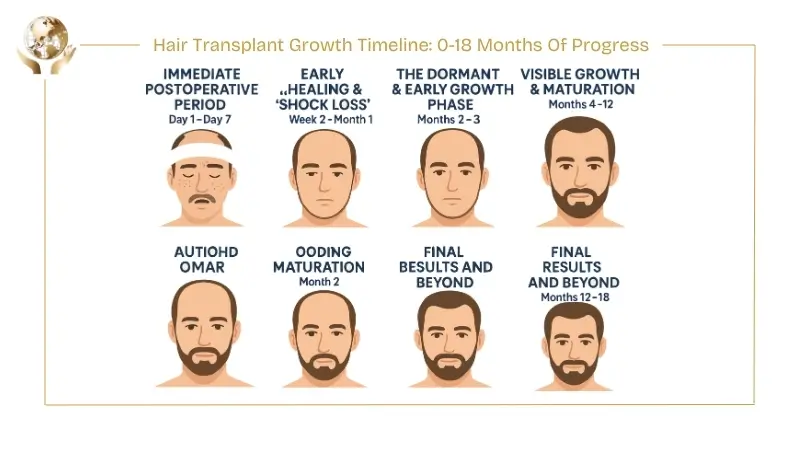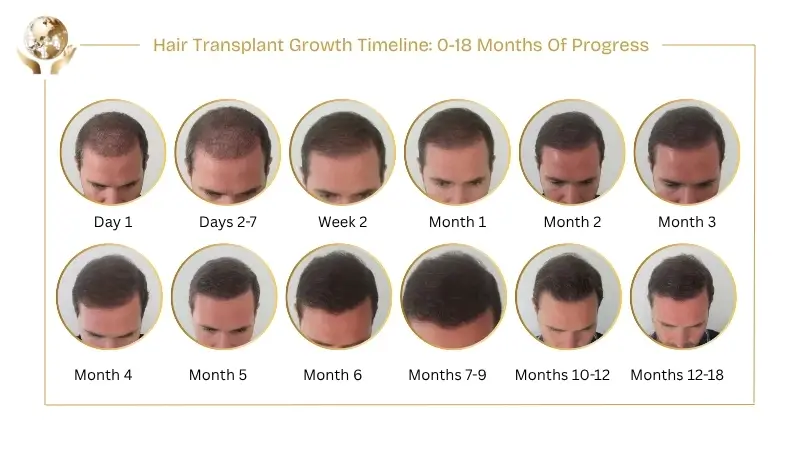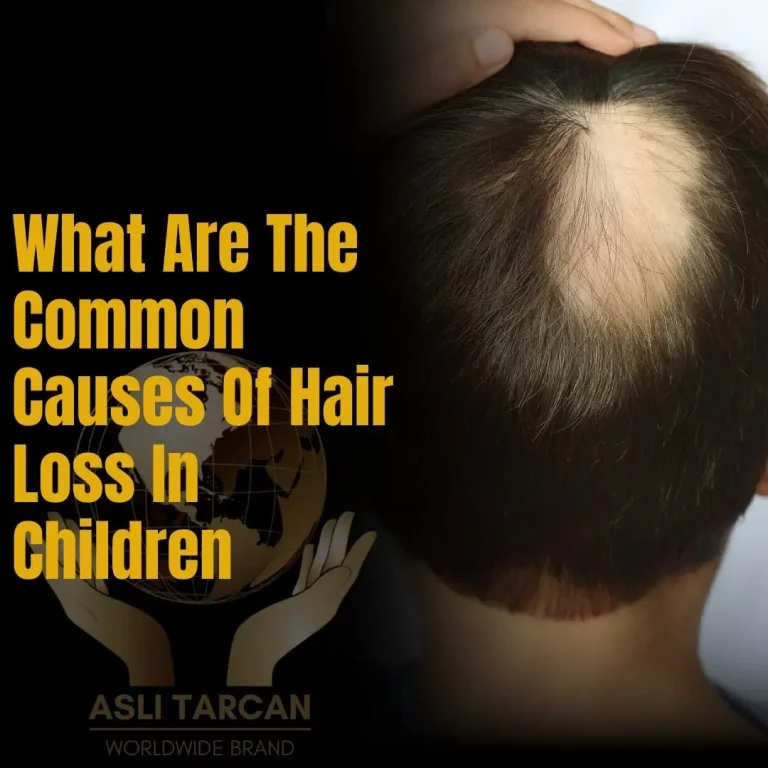Hair Transplant Timeline & Growth Chart | Track Your Progress
A hair transplant often proves to be a great option for people experiencing hair loss; offering a permanent solution for hair thinning and receding hairlines.
When considering a hair transplant, it’s crucial to understand that the results will improve over time. Unfortunately, it is not as simple as undergoing the procedure and then immediately having a full head of hair.
You must allow your scalp time to recover, as achieving thick and natural-looking hair takes time. This process requires patience, monitoring, and an understanding of the intricate growth phases that follow the surgery.
The article includes a hair transplant timeline and chart, so you know the stages from the procedure to the final result.

Understanding The Hair Growth Cycle

Understanding the natural cycle of hair growth is essential before starting the transplant timeline because transplant follicles follow this process. There are four major phases in the hair growth process:
- Anagen (Growth Phase): This is the active growth period, lasting 2-7 years. Most hair (80 to 90%) is in this phase at any given time.
- Catagen (Transition Phase): Hair growth slows for about 10 days, and the hair becomes finer as the hair follicle shrinks.
- Telogen (Resting Phase): Hair rests for 3-5 months with no further growth.
- Exogen (Shedding Phase): The final phase occurs when existing hair falls out, replaced by new hair from the same follicle.

Hair Transplant Growth Timeline: 0-18 Months Of Progress
Everyone’s recovery after a hair transplant is different, and the process takes time. A general outline of the process can help you know what to expect.
Immediate Postoperative Period (Day 1 – Day 7)
The first few days after the surgery are critical as the hair follicles are getting used to their new place.
Day Of Procedure (Day 1)
The first day after your procedure is important for a smooth recovery.
- Anesthesia & Immediate Aftermath: The procedure is performed using local anesthetic. You may notice slight redness and swelling in both the donor and recipient sites.
- Post Transplant Appearance: Tiny scabs will appear around the grafts, which is a normal part of the healing process.
- Postoperative Care Instructions: Keep your head elevated at 45 degrees while sleeping. Take prescribed medications, including pain relievers, antibiotics, and anti-inflammatory drugs.
Days 2-3
During days 2 to 3, you may experience swelling and tenderness in the treated areas.
- Expected Swelling: Swelling around the forehead and eyes may occur, but it is usually manageable. You might also feel slight itching and tenderness.
- Scab Progression: Scabs become more visible.
- Continued Care: Do not rub or touch the treated spots. Strictly follow all of the medication and bandage instructions.
Days 4-7
From day 4 to about day 7, you can expect the following signs and care for your treated area:
- Decreasing Swelling: Swelling in the affected areas usually begins to subside.
- Scab Evolution: Scabs become drier and darker as they heal.
- Initial Hair Shedding: In this early stage, hair shedding may occur as the transplanted follicles begin to rest.
- Gentle Scalp Care: You can start gentle shampooing the scalp with a mild shampoo, using a gentle dabbing technique to loosen and remove the scabs
- Daily Activities: Resume gentle activities, but you should still avoid both difficult exercises and direct sun exposure.
Early Healing & “Shock Loss” (Week 2 – Month 1)
You will experience a shock loss phase in the second week, but the condition improves as time passes.
Week 2
The second week will show improvement in your scalp condition:
- Scab Resolution: Most scabs will have fallen off by the end of this week, showing the tiny, red spots where each graft was placed.
- Reduced Redness: The skin will start to look less red.
- Shock Loss Phase: Temporary shedding of new hairs, known as “shock loss.” This is a normal stage since the follicles are gearing up to start a new growth cycle.
- Back to Routine: Most dermatologists recommend gently showering your hair regularly and gradually returning to workout routines.
Weeks 3-4 (Month 1)
Weeks 3 to 4 will bring further scalp recovery:
- Continued Shock Loss: Shock loss may persist, and some individuals may notice uneven shedding.
- Scalp Healing: The scalp will appear healed with minimal redness and pain.
- Optional Topical Treatments: Using topical products like Minoxidil on existing hair can encourage growth.
The Dormant & Early Growth Phase (Months 2-3)
From month 2 to 3, your hair follicles are preparing for growth.
Month 2
This month is primarily a dormant period:
- Bald Appearance: After shedding, the scalp might appear bald, as resting hairs have been lost.
- Follicle Preparation: Follicles are receiving blood nourishment and preparing for the next growth phase.
- Patience: Most patients will not see new hair growth, which can be frustrating, so patience is very important here.
Month 3
Month 3 will bring new progress:
- Initial Hair Growth: Toward the end of the third month or the start of the fourth, new hair strands may begin to appear.
- Characteristics of New Hair: The first hair strands are fine, thin, and may bend slightly. It’s normal because follicles are getting ready to grow.
- Future Thickening: Hair will thicken and improve with time.
Visible Growth & Maturation (Months 4-12)
During this timeline, you will notice visible results.
Months 4-6
In months 4 to 6, you will notice the following improvements:
- Hair Thickening: You will start to notice significant changes and growth. Thin baby hairs will thicken and become more noticeable.
- Increased Density: Hair density will continue to improve, and the transplanted areas become more visible.
- Blended Appearance: The texture and color of your hair will blend better with the new hair, enhancing your new look.
- Expected Growth: By the end of 6 months, most patients report about 60% of their new hair has appeared.
Months 7-9
As the months progress, hair growth will continue to improve.
- Continued Development: Hair will become longer, thicker, and more developed.
- Density Increase: A significant increase in density will make your hair appear more natural and blend seamlessly.
- Styling Versatility: You will be able to change your hairstyle more often, and your hairline will improve greatly.
Months 10-12
After 10 months, you are at the stage where you will notice the final results of your hair transplant treatment:
- Peak Growth: By 10-12 months, most of your new hair will have grown and matured, matching your expectations.
- Natural Appearance: Hair will achieve significant thickness and an absolutely natural look.
- Patient Satisfaction: At this stage, patients usually feel very satisfied with their results.
- Potential Continued Improvement: There is a chance that the crown’s thickness and density will continue to improve after one year.
Final Results and Beyond (Months 12-18)
After a year, you will see the final outcome as expected.
- Ongoing Maturation: At twelve months post-surgery, you will observe the primary benefits. However, the transplanted hair may continue to thicken and mature for up to 18 months, particularly in the crown region, while the hairline typically matures earlier.
- Peak Hair Fullness: By now, the hair is as full and thick as it will ever be.
- Final Results: You should have a clear understanding of your final hair transplant results.
- Future Maintenance: Maintaining a healthy diet and regular hair care is important, along with possibly taking any medications prescribed by your doctor to prevent future hair loss.

Hair Transplant Progress Chart: From Day 1 to Full Growth
Here’s a hair transplant growth chart from day 1 to 18 months, showing the progress of the hair transplant procedure:
| Time After Transplant | What to Expect (Appearance & Sensation) |
|---|---|
| Day 1 | Redness, swelling, tiny scabs, and visible transplanted grafts. |
| Days 2-7 | Swelling peaks then subsides, scabs darken, and initial shedding begins. |
| Week 2 | Scabs largely gone, redness fading, significant shock loss. |
| Month 1 | Continued shock loss; scalp looks similar to pre-op. |
| Month 2 | “Bald” or very sparse appearance, follicles dormant. |
| Month 3 | First signs of fine, thin new hairs emerging. |
| Month 4 | Noticeable new hair growth, still thin but improving density. |
| Month 5 | Hair visibly thicker and longer, better coverage. |
| Month 6 | Significant density improvement, 50-60% of expected growth achieved. |
| Months 7-9 | Hair continues to thicken and mature, approaching full density. |
| Months 10-12 | Near-final results, full density, and natural appearance. |
| Months 12-18 | Final maturation, especially for the crown, optimal thickness. |
Factors Affecting Hair Transplant Timeline

Many factors can affect the time it takes for a hair transplant and the outcome of the surgery:
- Individual Healing Rate: Recovery speed varies from person to person. Aging, previous health problems, and genetics contribute to this.
- Hair Characteristics: The size and type of your hair can influence how quickly your results become apparent. Thicker hair requires less grafting for a full appearance.
- Quantity of Hair Grafts: Larger areas for transplant, which use more grafts, may initially heal slowly and need more time to grow and develop.
- Surgical Procedures (FUE vs FUT): Both procedures have a similar growth process, but the donor areas heal at different rates. FUE removes individual hair follicles from tiny punches, while FUT removes a strip of tissue from the scalp.
- Surgeon Expertise: A skilled surgeon keeps grafts safe and in position, helping them stay healthy and giving natural results.
- Underlying Hair Loss Condition: Managing the root cause of hair loss, such as through the use of Finasteride or Minoxidil, can stop hair from being lost in the transplant area and help it stay healthy.
What Are The Post Op Instructions For Hair Transplant?

Follow these general guidelines after surgery to help ensure you heal well and grow strong:
- Graft Protection: Do not touch, rub, or scratch the treated area for the first two weeks.
- Gentle Washing: Wash your hair according to your surgeon’s recommendations, using a special gentle shampoo for the first few days.
- Sun Protection: Wear a loose hat or use sunscreen on your scalp for several months to guard it from sunlight.
- Elevated Sleeping: Raise the head of your bed or sleep in a recliner for 3-7 days to lower the swelling.
- Medication Adherence: Take prescribed medicines as directed.
- Follow-up Appointments: Attend follow-up sessions with your surgeon to ensure proper healing.

This article is medically reviewed by Medical Aesthetic Dr. Ali Khalil (PHD)
See Our Doctors & Surgeons
Frequently Asked Questions
What month of hair transplant has the most growth?
The most significant period of growth takes place between months 6 and 9.
How does a hair transplant look after 10 years?
After successful hair transplantation, the restored hair appears natural and secure, even if your native hair continues to thin.
Does transplanted hair go gray?
Yes, transplanted hair starts to turn gray like your own hair.
How do I know if my hair transplant is successful?
Successful treatment is marked by natural-looking hair growth and an excellent hairline.
Does the donor area grow back?
Hair extracted in FUE will not grow back, but in FUT, the removed area is hidden by the surrounding hairs.






